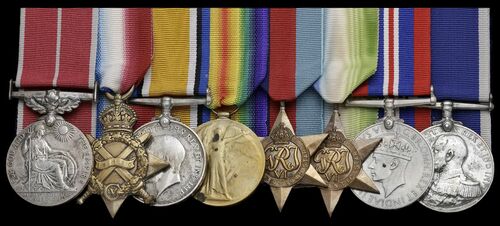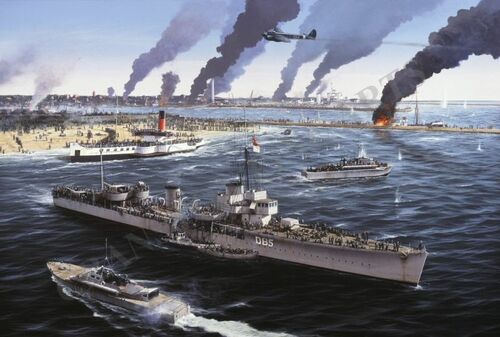Auction: 23001 - Orders, Decorations and Medals
Lot: 331
The 'saving the Shikari' 1943 B.E.M. group of eight awarded to Stoker Petty Officer E. T. Prowse, Royal Navy, a veteran of the Battle of Jutland, who joined the destroyer before the trails of Operation Dynamo when Shikari became the last Royal Navy ship to leave the beaches
Although his gallantry and skill saved the vessel from floundering, his reward was delayed when her Skipper was 'relieved with little notice'
British Empire Medal, Military Division, G.VI.R. (Ch. Sto. Edwin T. Prowse. D/KX86825. R.N.); 1914-15 Star (K.16030. E. T. Prowse, Act. L. Sto., R.N.); British War and Victory Medals (K.16030. E. T. Prowse. S.P.O. R.N.); 1939-45 Star; Atlantic Star; War Medal 1939-45; Royal Navy L.S. & G.C., G.V.R. (K.16030, E. T. Prowse. S.P.O. H.M.S. Frobisher), the Great War awards polished and worn, fine, the remainder better (8)
B.E.M London Gazette 14 December 1943, the original recommendation states:
'Has served in "Shikari" since commencement of hostilities. This rating in company with Mr. J. N. Hemmens, Wt. Eng. R.N., was instrumental in saving the ship when the after funnel was carried away in March last. No award was made at the time because the then Commanding Officer was relieved with little notice. This rating displayed considerable gallantry in dealing with a rapidly flooding boiler room where one boiler had to be kept alight. Failure to keep the ship under way with so large a hole in the upper deck would probably have resulted in the loss of the ship, while any hesitation in dealing with the situation would almost certainly have meant the blowing up of No. 2 when the water reached it and the then certain loss of the ship. This rating has always set a high standard of efficiency. No award has ever been made to any officer or rating of "Shikari" since the commencement of hostilities.
Edwin Theodore Prowse was born at Devonport, Devon on 5 May 1894 and enlisted with the Royal Navy on 12 September 1912. Posted to Vivid II as Stoker Class II, he was promoted Stoker Class I aboard the armoured cruiser Devonshire on 2 September 1913. Posted to the battleship Orion just prior to the war on 3 February 1914 he was promoted Leading Stoker just after hostilities on 26 November 1914.
This vessel was part of the 2nd Battle Squadron and the flagship of Rear Admiral Leveson. It was in this role that they joined Admiral Jellicoe's Grand Fleet as it left Scapa Flow to take part in the Battle of Jutland on 31 May 1916. Orion was the fifth ship in the British Line as it 'crossed the T' of the German fleet and fired a total of 51 of her 13.5-inch shells. She was notably accurate with hits to Markgraf and Lutzow during the fighting. This fire even managed to disable one of Markgraf's guns, not only knocking it out but killing the crew. The Lutzow had been hit by a number of warships and was scuttled not long after the battle.
Prowse continued to serve with Orion after the battle, being promoted Stoker Petty Officer aboard her on 1 September 1917. Posted to the monitor M31 in the last months of the war he was to leave her on 28 February 1919, going ashore to Vivid II. He served with a variety of vessels and shore establishments over the next decade, notably, Dauntless, King George V and Frobisher. Prowse was still serving as Chief Stoker by the outbreak of the Second World War, being posted to the S-Class destroyer Shikari.
This vessel had been used as a control ship on naval exercises but was withdrawn for service upon the commencement of hostilities in September 1939. Deployed for convoy duties around the coast in the Spring of 1940 she was transferred to Dover command as part of the evacuation of Allied troops from Dunkirk during Operation Dynamo. Deployed on operations here from 28 May 1940 Shikari was notably involved in rescuing French soldiers from the sinking S.S. Prague off Gravelines on 1 June. She gave further aid to her allies over the next few days as the withdrawing French troops who had been guarding the Dunkirk beaches were evacuated. Indeed she was to prove the last of the Royal Navy ships to make the dangerous run in as the German Army closed on the Allied enclave, exchanging fire with shore batteries as she escaped the net.
On the completion of the evacuations Shikari was posted back to convoy duty, being given Atlantic duty in September. Stationed on convoy defence in the North-Western Approaches in March 1943 it was here that the ship hit bad weather and would have foundered without the work of Prowse and Warrant Engineer Hemmens. Despite this they would not receive an award for some time as a result of changes to command. The words of Commodore Simpson, responsible for the destroyers in the Western Approaches give further details:
'This rating would normally have been recommended for an "Operational" award for the services mentioned above. Owing to the sudden change of Commanding Officer, it was decided to delay the recommendation until the present occasion of rendering "Periodic" recommendations.'
Shikari survived her ordeal and was later active in Operation Rosegarden while operating out of Iceland. During this time she faced heavy attack from U-boats before returning to the North-Western Approaches. She had served faithfully for much of the war but by this time the S-class was being replaced by the American leased Captain-class. Shikari was withdrawn from Operations in September 1944 and saw only training duty for the rest of the war; sold together with copied research comprising, a former auction listing, recommendation for award and service papers as well as information on the actions of H.M.S. Shikari and a London Gazette extract.
Subject to 20% VAT on Buyer’s Premium. For more information please view Terms and Conditions for Buyers.
Sold for
£520
Starting price
£700







